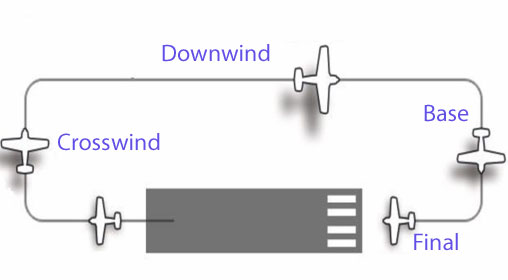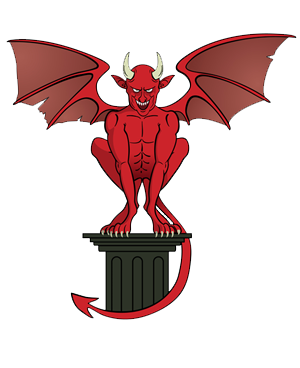Example Circuit
Summary
Student Flexwing Microlight Pilots will initially start practicing Airfield Circuits.
The student pilot will take off, fly round the “circuit” and land (or do a “touch and go”) This gives the pilot experience in taking off, practicing flying in an environment with other aircraft and then landing again. For this example, I have documented the procedure from starting to parking, including examples of Radio calls.
All Pilots should go through safety checks before starting the aircraft, before take off, and during flight. Most instructors will use Mnemonics to make checks and procedures easier to remember. Some instructors use slightly different ones, but they will all be pretty similar.
Aircraft Pre-Flight checks
Before any flight a pilot should perform ground checks to satisfy him/her self that the aircraft is fit to fly. This is an example checklist of things to check on a microlight flexwing.
Wing Crossboom retention wires, secure no twist
Rear Flying wires Secure without broken strands at swages
Sail Battens in place and secure
Trailing edge Undamaged, open zips to view double flying wires at front, nuts secure, no fraying
Leading edge Undamaged
Nose catch In and secure
Noseplates Undamaged
Control Frame Undamaged, nuts and bolts OK
Front Flying Wires Nuts and bolts firm, loose to swivel, swage OK
Trike Propeller No damage or abrasions, prop tape intact bolts tight
Gear Box Seals not leaking, acceptable play in bearings
Plug Caps Secure, HT leads dressed correctly
Carburettors Rubber manifold intact, air filter and carbs secure, fuel hose
Exhaust Pipe Secure, grommets, brackets, springs, weld cracks
Oil Level Check within limits
Water Level Check Fluid level
Seat Frame No bends or distortion, seat belt webbing
Hand Throttle Operation check and no fraying at wire ends
Ignition Switches Secure, wiring sound
Monopole/Pylon Locking system, secure.
Trike Keel Look for bends or distortions
Front Stub Secure to Front Strut lugs without cracks or bends
Foot Throttle ‘Click’ / free operation,inspect for frayed cables
Rear Wheels Tyre pressures,spats, Mud(winter) Grass (summer)
Front Wheel Tyre pressure, front forks straight
Instruments Secure in dashboard, undamaged
Trike Fixings Hang bolt, front strut pins in place
Fuel Amount required, cap on, hoses secure, vent open, tap ON
Pre-start
Before starting the aircraft up, pilots will use STAMP:
- S – Security – make sure that both Pilot and passenger are secured with seatbelts and that helmets are secured. Pilot should check this for passenger manually, not just ask.
- T – Throttle – make sure that the hand throttle is in the off position and the foot throttle is free and foot is not activating it. Also consider choke if required.
- A – Area – Check the surrounding area in front, to the side and especially behind the aircraft to make sure no one is in the vicinity before starting the engine.
- M – Mags – Switch both the magneto switches to “On”
- P – Cover the Microphone and shout a warning (CLEAR PROP) as loud as possible
Have another check that the area is clear and start the engine.
Radio Call on Apron (Perth)
As an example, this is a typical radio call at Perth Airport after starting the aircraft.
Pilot: “Perth Radio, this is Golf Alpha Bravo Charlie Delta, requesting Radio Check and Airfield Information for circuits, 2 POB (persons on board) with 2 hours endurance (flying time).
Perth Radio: “Golf Charlie Delta **, good morning, Readability 5 (loud and clear), runway two seven right, QFE one zero zero two, QNH one, zero one six
**** G-ABCD can be abbreviated to Golf Charlie Delta only after Radio Operator has said it first” **
Pilot (Reads back to confirm): “runway two seven right, QFE one zero zero two, QNH one, zero one six, Golf Charlie Delta”
The Pilot now knows what runway is currently being used and the altimeter settings.
Radio Call - Moving to Holding Point for Checks
Pilot: “Golf Charlie Delta Taxying to holding point Charlie for Checks” ** G-ABCD can be abbreviated to Golf Charlie Delta only after Radio Operator has said it first” **
Perth Radio: “Golf Charlie Delta” (just an acknowledgement that your transmission was received)
Pilot Checks at Holding Point
At the holding point, the pilot will turn the Microlight into the wind, while not blocking the holding point (to allow other aircraft to continue if they have completed their own checks. The pilot will use the mnemonic : CHIEFTAP
- C – Controls – The pilot will move the bar fully to the left and the right, and forward and backwards to ensure there is nothing going to snag, or cause any problems in the air.
- H – Harness’s and Hatches – The Pilot will again check both his own and the passengers helmet and seatbelt to make sure they are secure. The Pilot should also check the Hatches (semi circular zips on wings, and Velcro cover in centre on most flexwings) These should all be closed, if they are not, it could cause the aircraft to be unstable in flight.
- I – Instruments – the instruments on the aircraft should be checked to make sure they are working. Temperatures and Pressures (T’s & P’s) should be correct before attempting take off. The Altimeter should be checked and set to the correct QFE setting.
- E – Engine Magnetos – The engine speed should be increased for this test and kept at an even speed. Then each Mag switch should be switched off independently. The engine should continue to run with one switched off, and the pilot should notice a temporary dip in revs when switched off. When confirmed, the mag should be switched back on and the other one tested and switched back on. This test confirms that the 2 separate ignition circuits are working and capable of working individually
- F – Fuel – Make sure there is enough fuel for your flight, as well as extra, in case you needed to divert.
- T – Trim – adjust the wing trim for takeoff. Also check the “Tangs” ( the circular security catches on the airframe, and including the Main “Jesus” bolt directly above the Pilot. You may have checked this in your pre-flight checks, but should be done just before flight.
- A – Area – make sure that the area is clear, and establish any inbound traffic, by a vigilant lookout and also listening to any radio transmissions. Even if you don’t have a tower radio, any incoming traffic should report “downwind” and “Final” to give you information.
- P – Power – You will use full power on take off to test the engine.
Radio Call - Prepare for Take Off
In this scenario, the pilot will be using runway two seven (right). The closest holding point will be “Charlie”. The pilot will want to use as much of the runway as possible, so needs to taxi up to the end of the runway and then turn ready for take off. This is called “Backtracking” the runway. The pilot will listen to the radio to identify any aircraft that is on the circuit (either downwind or final). He will also make sure he checks visually to see if there is any aircraft that could affect him taking off.
Pilot: ” Golf Charlie Delta entering and backtracking 27 for departure”
Perth Radio: “Golf Charlie Delta” ( just an acknowledgement that your call was received)
Radio Call - Taking Off
Pilot: “Golf Charlie Delta taking off runway two seven”
Perth Radio: “Golf Charlie Delta wind (xx) at (xx) Knots”
** the words “Take-off” should only be used when actually taking off. For instance pilot would “Backtrack for departure” – not “backtrack for take off”
Pilot Checks - In Flight (all flights)
- L – Lookout – always constantly looking for other aircraft all around
- I – Instruments – check T’s & P’s (Temps and Pressures)
- F – Fuel – make sure enough fuel including extra in case of go-around
- E – Endurance
Radio Check - Report Downwind
Pilots should broadcast on the radio when they on the downwind leg of a circuit to let other aircraft know where you are and your intention. This allows other aircraft to make decisions based on your location and what you are planning to do:
Pilot: “Golf Charlie Delta downwind runway two seven for touch and go (or to land)
Perth Radio: “Golf Charlie Delta” (just an acknowledgement that your transmission has been received)

Downwind Checks
While on the downwind leg, the Pilot will perform some safety checks in preparation for landing. The mnemonic used is “FAWNTS”
- F – Fuel – check there is enough fuel and extra in case a “Go-Around” is required
- A – Aware – keep a sharp lookout for other aircraft in the circuit, be aware what is landing and taking off
- W – Windsock – check the windsock to make sure that the wind has not changed significantly and that it favours your intended runway
- N – Nose Wheel – make sure the wheel is pointing straight ahead
- T – Throttle – make sure the hand throttle is off
- S – Security – check that you and your passenger are still strapped in and your helmets secure
Radio Check - Final
Aircraft Shutdown Procedure
When parking the aircraft, consideration is made to the wind direction. Different aircraft will be parked differently: Some will be parked with the wing dropped down into the wind (so wind doesn’t lift aircraft) some with smaller wings will be parked with the wing level. All wings should be secured so it cannot move, and the foot brake lock applied. The Mags should be switched off (to stop the engine) and the radio switched off. Ignition should be switched off.

